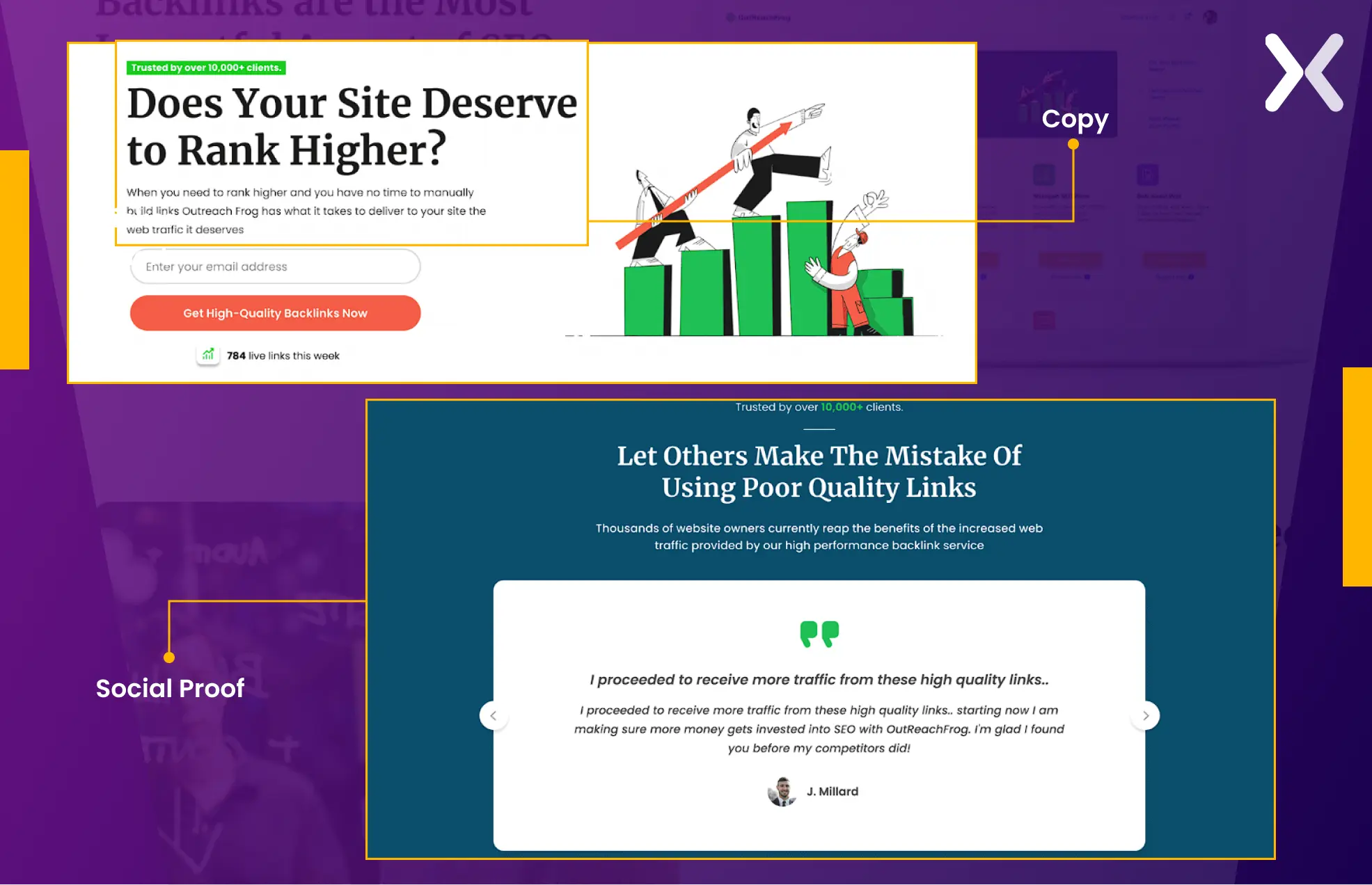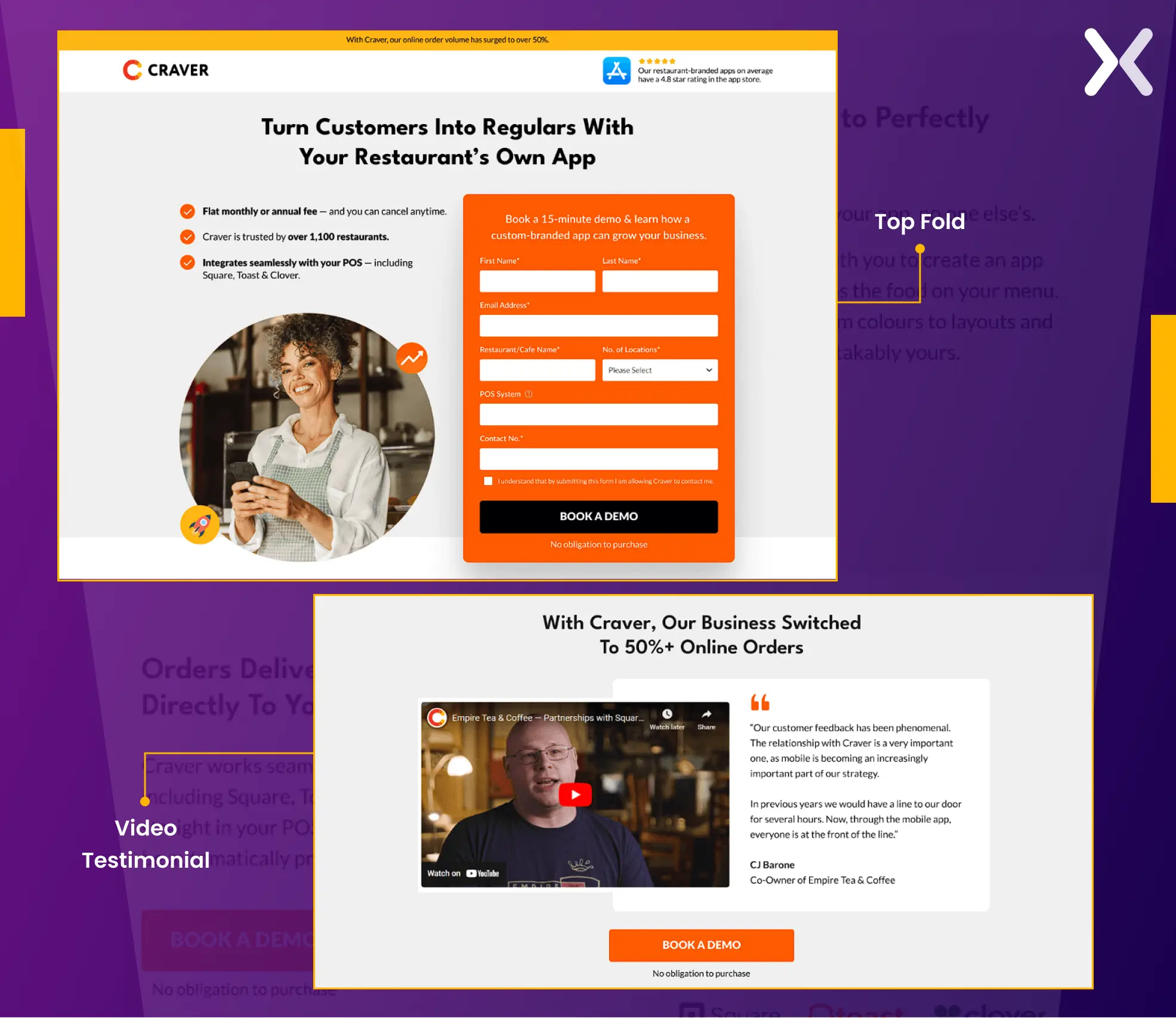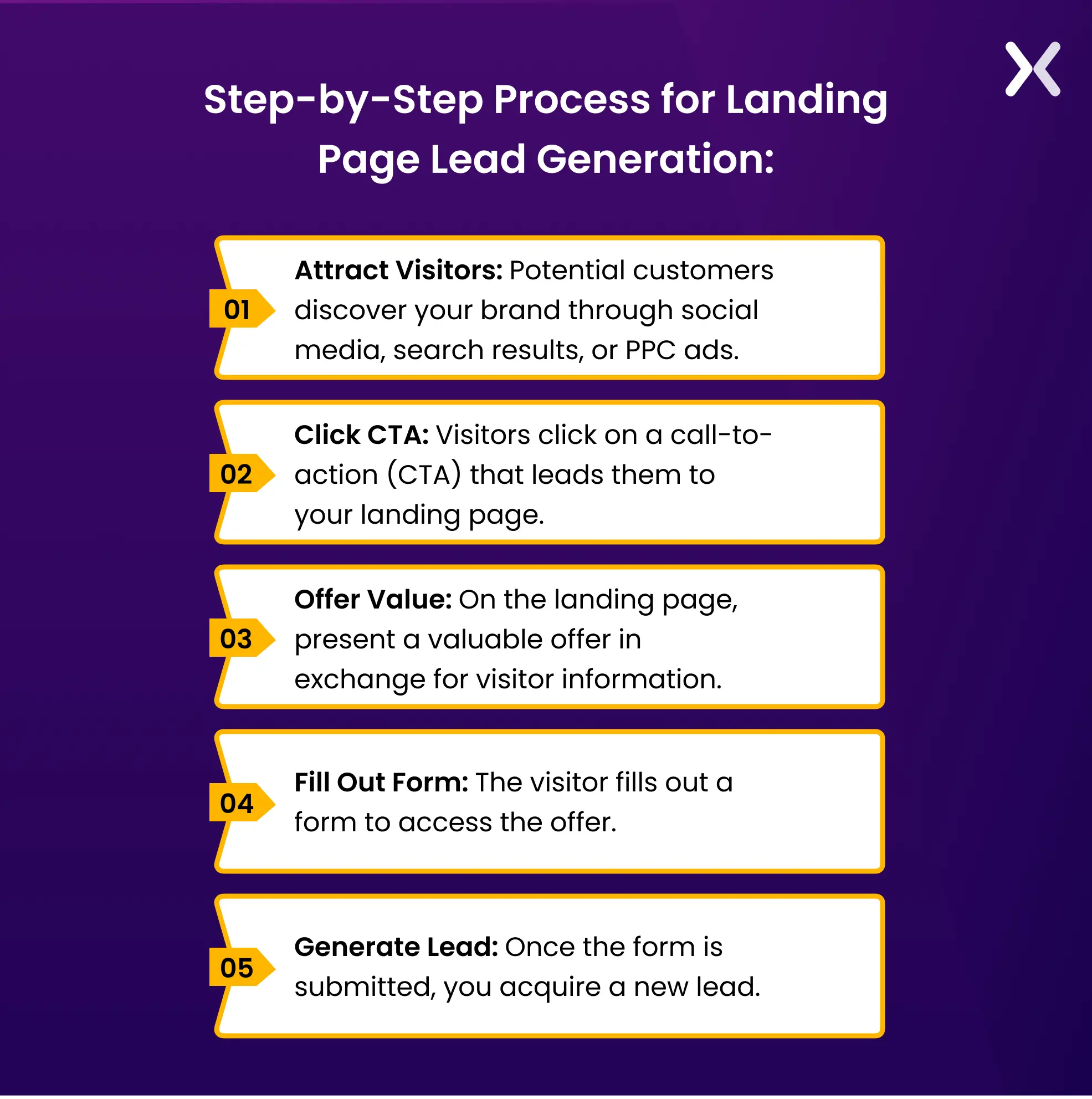Effective landing page lead generation drives high-quality leads into your sales funnel.
While your PPC ads capture the audience’s attention, the landing page is critical in converting visitors into leads. Designed specifically for this purpose, a lead generation landing page ensures your efforts deliver measurable results.
But any landing page design will not do for your lead generation. You need to know the specific elements lead gen landing pages must have to maximize their conversion potential.
This article will dissect some of the lead generation landing pages Apexure has built over the years, offering insights into their design and effectiveness. Later, we will round up the article by pointing out the best practices we use to build impactful landing pages for lead generation.

A lead generation landing page is a dedicated webpage designed to capture visitor information. These lead gen pages help populate your sales funnel with quality leads, focusing on addressing visitor pain points and positioning your product or service as the solution.
These pages aim to generate leads rather than make actual sales. Hence, their forms are minimalistic, and more emphasis is placed on ensuring visitors understand the value they will receive if they fill out the form.
Now, let’s analyze various lead generation landing page examples.
Now, let’s analyze various lead generation landing page examples.
PrimeSync’s lead generation landing page flaunts a solid color palette that aligns with its brand style. The page has an ample amount of breathing space, with each element placed with conversion in mind.

Quantified Social Proof: The landing page’s first fold ends with social proof that shares the brand’s performance statistics. Such quantified social proof is easy to grasp and helps build credibility immediately.
Kicker Short: Kicker shorts are phrases used to introduce the headline. Every headline on this lead gen page has a complementing kicker short highlighting benefits like ‘24x7 availability’ and ‘Remote-First Flexibility.’
Highlighting USPs: The page has a dedicated section to showcase all the USPs their services offer. In this segment, instead of listing many benefits, the landing page copy focuses on just three USPs that solve crucial pain points of the target audience.
Get Change SaaS lead generation landing page targets a distinct niche reflected through the design and copy. It features clean typography and visual icons, emphasizing clarity and user engagement. The whole page follows a user-centric structure.

Form: This is a lead generation page, so the form is kept short by asking for only the visitors’ essential information. This reduces conversion friction and ensures users aren’t overwhelmed while filling out the form.
CTA: The color of the CTA button has been chosen aptly. It stands out in every section without disturbing the page’s design, and the CTA spread across the page warrants visitors’ easy conversion at any section.
Final Banner: Right after the FAQ section, a final CTA banner is present. It reinforces the page’s primary message, reminding visitors of the value proposition before leaving. Strategically placed at the end, it captures the attention of users who scroll through the content, maintaining engagement and boosting conversion rates.
Outreach Frog’s lead generation landing page showcases a design tailored for target businesses. The layout effectively integrates call-to-action buttons and dynamic features like sliders to maximize user engagement.

Copy: The copy of this lead gen page has been crafted for readability and impact. It extensively utilizes bullet points to ensure all crucial information is easy to grasp. The page also has sections that answer the ‘Whys’ and ‘Whats’ of the services, along with segments that clarify the right time to opt for Outreach Frog’s services. This represents a solid copy for a lead generation landing page with useful information.
Social Proof: The social proof segment on this page is worth noting. It has a fantastic kicker short that further builds up the social proof. The section becomes more impressive with the supporting headline and subhead.
Aimed at generating leads for a custom mobile app called Craver, this SaaS lead generation landing page that offer booking a demo leverages bold visuals, clear messaging, and an intuitive design. It features client-focused benefits and strong call-to-action areas that are optimized for conversions.

Top Fold: The lead gen page has one of the most immersive hero sections. The headline directly communicates the benefit of Craver services, which is further emphasized by the USPs and highlighted in bullet points throughout the subhead. The hero image used is highly relevant to the target audience, adding to an impressive first impression of the page.
Video Testimonial: Craver’s landing page effectively builds trust and demonstrates the tangible value of its services with a compelling video testimonial. This dynamic element captures attention, fosters credibility, and communicates the benefits of its offerings.
Intuitive Layout: The landing page is crafted for user-friendly navigation and efficient communication of key information. The well-organized sections ensure visitors can quickly grasp the app’s value proposition. A logical flow guides users from problem identification to solution highlights and finally to actionable steps.
The IMD’s lead generation landing page is designed to foster user interactions. It features a full-width hero image and numerous other amazing elements that engage visitors.

Multistep Form: To reduce conversion friction, IMD’s landing page features a multistep form that allows users to provide their information in manageable stages rather than overwhelming them with a single long form. This approach enhances user experience by breaking the process into smaller, easily digestible steps, maintaining engagement, and reducing the likelihood of users abandoning the form.
Relevant Social Proof: The landing page creatively integrates powerful social proof to resonate with their target audience, professionals aiming for a transformative career boost. By showcasing a timeline of successful alumni, the page highlights their program’s prestigious and global impact.
The PosePets lead generation landing page combines a playful design with engaging visuals and big typography to appeal to pet enthusiasts. It features animation, sliders, and clear calls to action tailored for the target audience.

Playful Design: The page uses bright colors, pet-themed visuals, and subtle animations to create an inviting, cheerful experience. This design effectively resonates with the target audience—pet owners who value personalization and warmth.
Clear Calls-to-Action (CTAs): The CTAs are concise, strategically positioned, and aligned with the user’s intent. They guide visitors smoothly through the page, maximizing lead capture opportunities.
User-Friendly Layout: The layout balances visuals and text with easily navigable sections and pet-centric imagery. Features like sliders enhance interactivity while keeping the page engaging and functional.
This lead generation landing page targets homeowners with a professional, trust-building design. It includes testimonials, quality images, and strong CTAs for generating remodeling service leads.

Click-to-Call Button: The header includes a prominent click-to-call button, ensuring users can quickly contact the company for consultations or inquiries, especially on mobile devices. This feature prioritizes convenience and accessibility.
Complementary Visuals: The imagery is meticulously selected to highlight beautifully remodeled homes, resonating with the target audience of homeowners. These visuals showcase the brand’s capabilities and evoke inspiration and trust, aligning with the remodeling industry’s aesthetic expectations.
Focused on financial services, the Rocket Money page utilizes big typography, bold CTAs, and clean design elements to simplify user interactions and boost conversions.

Bold and Clear Typography: The page utilizes large, easy-to-read text to communicate its value propositions succinctly, drawing attention to key benefits such as savings and budgeting tools.
Conversion-Oriented Layout: It employs a clean, structured layout with prominent buttons like “Sign Up” to streamline the user journey, reduce barriers to action, and increase lead capture.
Streamlined Design: The minimalistic visuals focus on utility and clarity, enabling visitors to absorb information and navigate the page without distraction quickly.
The Loans4Business page is designed for B2B audiences. It highlights clear CTAs, detailed information, and professional visuals to streamline lead generation.

Sticky Navigation Bar: The sticky navbar ensures effortless navigation, allowing users to jump to key sections such as loan benefits or FAQs. This feature particularly benefits users seeking specific information without scrolling through the entire page.
Professional Visuals and Tone: The clean and corporate aesthetic, combined with professional imagery, establishes a trustworthy and approachable brand image essential for appealing to business-oriented clients.
You have done a fantastic job developing your brand and designing a website that reflects it. Now, you’ve got to ensure that all that hard work turns into sales. If you’re looking for an efficient lead conversion tool, landing pages are the best way.

A landing page lead generation process is a great way to drive traffic, boost your SEO, and create your own brand. It can also be part of a successful PPC strategy. Approximately 68% of B2B companies use landing pages to generate leads for potential conversion.
44% of these clicks are directed to home pages, which is not a good plan. When used with PPC, landing pages direct clients to a particular product, service, or deal and inspire them to take action; this is your chance to generate conversions and develop your customer base.
Now that we understand how lead generation fits into the inbound marketing approach let’s go through the lead generation process for the landing page.

On the landing page, visitors can fill out a form in return for an offer. This means you’ll have a new lead.
To summarize, a Visitor clicks a CTA that takes them to the landing page. There, they fill out a form to get a bid, at which point they become leaders.

Let’s discuss some landing page lead generation best practices and tips:
In general, you need to ensure that your layout is straightforward and understandable to all. Landing page content, be it the visuals or the copy, must be aligned precisely with your goals and the target audience’s needs.

To build a successful design:
Start with the landing page format and wireframe.
Harmonise the colors of your theme.
Clearly distinguish between the “titles” of your paragraphs
Play with shapes and symmetry
Remember to let your text breathe to make it easier to read.
Use an appropriate amount of white space for a clean design.
If you offer several deals, one tip is to highlight one in relation to the other: concentrate your leads on a single offer.
The call to action is one of the things you need to pay attention to when you’re working on your landing page. As a reminder, a call-to-action button is an aspect of your landing page lead generation intended to cause an action. You can use various categories of landing pages for building mailing lists, selling products directly, or asking users for a free SaaS trial, keeping the CTA aligned with the desired action.

There are many potential actions; below are some of the most common ones:
Subscribe to your newsletter (email)
Registration form (personal details)
Free trials (personal and bank details)
Buying a product/service
The reservation of a facility
Ask for a callback/contact

“Chatbots can be effective on lead generation landing pages, but their success depends on proper implementation. It's important to be transparent by identifying the chatbot so users know they are interacting with a bot. The effectiveness of chatbots also depends on factors such as industry, website traffic volume, and overall goals, which should be evaluated before adopting a chatbot strategy.”
When it comes to landing pages that generate leads, the form is the final step: the quality of this aspect will decide whether visitors can leave their personal details.

The instructions for developing a form on a lead generation landing page that converts are very close to a successful call to action:
Make the form stand out from the rest of your website
Use appealing colors
Propose a simple and interesting offer
Only keep the necessary form fields

“Forms should be brief and should only request necessary information. Compared to lengthy forms, a three-field form (name, email, and interest) increased our leads by 40%.”
Customer testimonials for your landing page lead generation act as social proof: the more you share, the more you reassure your page users. The human brain searches for identifiable forms, common names, and similarities: make it happy!


“Always include social proof—testimonials, reviews, or case studies. For example, we added two short success stories to a client’s landing page and saw a 15% lift in form completions.”
Highlighting your offer’s benefits on a landing page is crucial to engage visitors quickly. Your unique selling points (USPs) should be front and center, emphasizing why your product or service is the solution they need. This can include highlighting features, customer testimonials, or any guarantees. By clarifying these benefits, you capture attention, build trust, and motivate users to act, increasing your conversion rates.

“To improve landing page lead generation, focus on identifying your target persona's problem and clearly explain how your business solves it. Use trust-building elements like testimonials to reinforce credibility and show empathy, which can boost conversions.”
Landing page lead generation becomes easier when you understand which elements will convert visitors into leads.
Whether you have a SaaS, services, or an eCommerce business, having an optimized landing page is essential for targeting high-potential leads. By focusing on design elements such as clear CTAs, engaging visuals, and intuitive navigation, you can enhance the user experience and drive conversions.
Consistently updating and testing these elements will ensure that your landing page remains effective in capturing valuable leads. A well-crafted landing page helps you stay proactive in lead generation and business growth.
Did you know that Apexure has 100+ blog posts on landing pages? We have shared everything, from creation to testing, analysis to optimization. Check it out before you build your landing page.
Making an event landing page on your own can be overwhelming. Get the help you need from our experts. Book a call and one of our landing page experts will contact you soon.
Check out our landing page portfolio to discover conversion-friendly landing page elements that might. Filter your industry and check which landing page design is trending.
A/B test headlines, forms, visuals, and CTAs to optimize results.

Related Articles:
Drive More Sales or Leads With Conversion Focused Websites and Landing Pages
Get Started.png)
In today’s fast-paced digital world, having a responsive website is no longer just a nice-to-have, it’s essential. Whether...
As artificial intelligence continues to evolve, businesses are finding innovative ways to enhance their marketing efforts. One of...
Get quality posts covering insights into Conversion Rate Optimisation, Landing Pages and great design